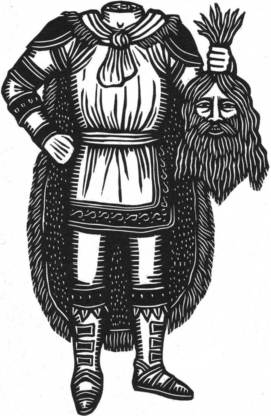

Taller Martín Pescador
Announces the Publication of a New Book for 2013
Sir Gawain and the Green Knight
A New Translation by JOHN RIDLAND with Illustrations by ARTEMIO RODRÍGUEZ

Sir Gawain and the Green Knight tells a serious, exciting, and often amusing story, which is so skillfully
handled that its unknown author has been ranked with Chaucer among the best
Middle English poets. For various reasons the poem has not been as widely known
as The Canterbury Tales. Chaucer’s work survived in dozens of manuscripts, whereas Gawain survived by the skin of its teeth, bound in one small volume with three other
long poems, probably by the same author, saved from a library fire in the early
Eighteenth Century, but not printed until the mid-Nineteenth Century.
The resulting eighty-eight page large quarto is of spacious proportions. The paper, made by Pasquale De Ponte in San Lucas Tepetlaco, is of just the right shade of green, neither too dark for legibility nor too coy for
seriousness. The Bembo Titling and Poliphilus types were cast by Bradley
Hutchinson in Austin, Texas, then shipped across the Rio Bravo with many an adventure at the customs office, and finally printed with the utmost care at Taller Martín Pescador in Tacámbaro, Mexico, on a Vandercook hand press. Meanwhile, the renowned illustrator Artemio Rodríguez, a few miles, or,

Nor was he lucky in where he lived–somewhere in the Midlands near Cheshire, apparently–far from the heart of things in London. The Northern dialect of Middle English in which he wrote was submerged by Chaucer’s Southern version in the development of the present English language that we
consider ours, which makes the reading of Sir Gawain in the original a heavy task even for graduate students of English. As a
result, the poem has been translated into Modern English many times since it
resurfaced but never in the easily accessible adaptation of traditional ballad
meter employed by John Ridland in this version. Most recent translators have
attempted to revive the alliterative accentual meter which was already called
by scholars the “Alliterative Revival” when our Gawain poet was writing it. It was a great game, but needing to have
its workings explained spoils the reader’s fun.
as the colophon has it, “several kilometers up the hill” from Pascoe’s workshop, produced his immaculate linoleum cuts to be placed as strategically
as the original author’s divisions of the work. The majority of the edition has been bound by the
printers, sewn on vellum tapes and laced into a dark green stiff paper cover, the structure reminiscent of a classic limp vellum binding. Twenty-six copies, lettered from A to Z, were
set aside to be bound in quarter vellum hard covers with a handsome slipcase, by Jace Graf of
Cloverleaf Studio in Austin, Texas.
The desires of all participants (except the original author’s) were demanding, and in the end only two hundred copies were “accomplished” (the Colophon’s mot juste again), with superb timing on Christmas Day, Two Thousand and Twelve–superb because that is the day on which the story begins, and, a year later, its
last stage begins to unfold.

In addition to the unusual merits of the translation, seldom if ever has the poem been
presented in so finely designed and printed an edition as this from Juan Nicanor
Pascoe’s Taller Martín Pescador in Tacámbaro, Michoacán, Mexico. Juan Pascoe’s books exemplify the classical tradition he learned from the late Harry Duncan
at the Cummington Press and Abattoir Editions.
Click on the Green Knight for photos of the book.
Copies of the regular edition are available for four hundred and fifty dollars, and the
quarter vellum copies with slipcase can be had for one thousand and fifty dollars.

